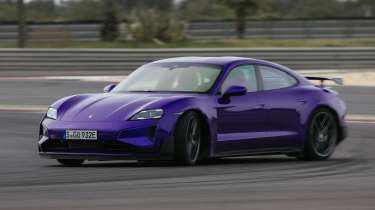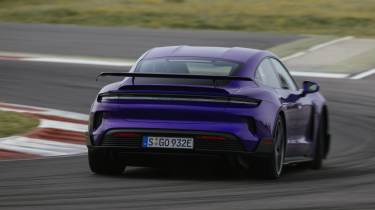Porsche Taycan Turbo GT Weissach Package review: two seats, 1020bhp and £186,300
We’ve driven the new, record-breaking Taycan Turbo GT – it’s astonishing in some ways but confusing in others
The Turbo GT is a new, very different kind of Taycan. Porsche’s first EV shifted our perspective on what kind of poise, precision and ability an electric car could deliver when it arrived in 2019, but this 1020bhp track-prepared flagship explores the very extremes of what the platform is capable of. In some ways, the results are spectacular, but why the GT exists – and precisely who it’s for – is a little more complicated.
The GT benefits from Porsche’s latest battery, powertrain and chassis technology that has been applied elsewhere in the new Taycan range, and the headline figures are stunning. Activate launch control and GT generates 1020bhp and 988lb ft of torque from its two electric motors (you get 778bhp the rest of the time). The 0-62mph sprint is covered in just 2.3sec, yet the most powerful Taycan of all can also achieve 345 miles from a charge – 30 more than the 593bhp BMW i5 M60.
Opting for the no-cost Weissach Package trims a tenth from the 0-62mph time, and adds underbody air deflectors and a fixed carbonfibre rear wing for 220kg of downforce. It brings numerous lightweighting measures too, including a pared-back audio system, less cabin insulation and a manually-opening charge port. You also lose the rear seats, Jaguar Project 8-style. The result? A five-metre long, two-seater saloon car that still weighs 2220kg. It makes no sense to us either.
More reviews
In-depth reviews
Reviews
It's important to note that, somewhat misleadingly, the Turbo GT has not been directly developed by Porsche’s GT department – despite the name and the option of a Weissach Package. It does, however, feature bespoke chassis tuning, tyres and brakes to keep up with that crushing straight line performance, with standard-fit carbon ceramic brakes and Pirelli P Zero R (or optional Trofeo RS) tyres tailored specifically for the car. The suspension calibration is unique, using Porsche’s newly introduced Active Ride technology. It’s a very clever system, using electro-hydraulic pumps to regulate flow inside each damper for precise control of suspension support at each corner of the car. It’s powerful enough that the Taycan doesn’t need conventional anti-roll bars.
How does all that feel? At first, completely overwhelming. Our time in the GT was confined to the track, and no matter how firmly you’re braced in its carbon bucket seat, the brutal accelerative force takes your breath away. Pull the right-hand paddle to activate Attack mode for a 10 second 161bhp boost and the Taycan reaches 174mph at the end of Monteblanco’s pit straight, by which point you become very conscious that there’s an awful lot of momentum that needs to be shed in time for the first corner. The carbon ceramics are up to the job – just – but the soft initial pedal travel and blend of regen and friction braking make it difficult to modulate around the ABS. This naturally dials back your commitment by a few percent, but the Taycan starts to show its ability once into the meat of a corner.
You’ll recognise the crisp, linear steering response from Porsche sports cars, and the way the Active Ride system counteracts pitch and roll is uncanny. In a car this heavy you’d normally need to slow down your inputs to allow the mass to settle, but not so in the GT. Turn in on the brakes and you can feel the car working all four contact patches rather than leaning heavily on the front axle, and the body stays almost completely flat during hard braking and throttle inputs.
Push harder and the limiting factor is the tyres. They begin to squirm and complain under the enormous cornering forces and the Taycan loses some of its alacrity and precision – the optional Trofeo RS tyres help enormously in this regard, keeping the GT keyed in when driving with more aggression. As you gain confidence, trusting that the array of electronics won’t bite back, you begin to drive the Taycan more like a traditional supersaloon. You can neutralise the car with controlled amounts of throttle, or indulge in the Taycan’s playful side by adding more, and doing so feels more intuitive than you’d expect given the complexity beneath.
And yet, while the Turbo GT is an impressive showcase of Porsche’s full EV engineering might, it’s hard to ignore the fact that this £186,300 electric car – yes, you read that right – is unlikely to see many track days, and those that can afford one probably have a more suitable, purpose-built machine in the garage already. Pairing one of those with a Taycan 4S is how we’d spend the money instead.






